History & Culture

The Loire Valley portrays a scene of centuries of conflict and war ruins contrasted by the lavish castles and lifestyles of French Kings and queens. The cultural and historic heritage of the Loire Valley is found in its villages, the architecture of the many chateaux and castles and in the works of art in many national museums.
The Renaissance
The French Renaissance refers to a social and artistic movement throughout France from the 15th to the 17th century. It was an influencial period which saw the increase of humanism, and the beginning of new social systems and etiquette. The Renaissance influenced the importing and introduction of new artistic forms and techniques, in the artistic fields of architecture, painting, and sculpture, as well as science and literature.
The period of the French Renaissance extends from the reign of Charles VIII and the French invasion of Italy in 1494, until Henri IV's death in 1610. However the reign of Francois I (1515-1547) and his heir, Henry II (1547-1559), are often considered the climax of the French Renaissance.
It was during the reign of Francois I, and due to his love for Italian design, that Mannerism art flourished. An art practice identified by visual rhetoric and its use of mythology and allegory, practiced by Italian artists such as Michelangelo and Parmigianino . However, perhaps the finest art production of this time was the elaborate construction of many of the Loire chateau. The magnificent chateaux became palaces of pleasure with their facades reflecting their Italian influence and their stunning locations advantageously nestled in the tranquil Loire Valley.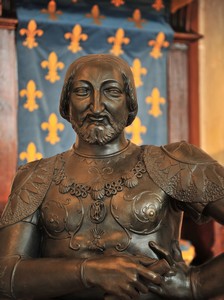
Upon the invitation of Francois I, it was the Chateau du Clos Lucé, near the Chateau d'Amboise, where Leonardo Da Vinci spent the remaining three years of his life (1516-1519). During these years Leonardo Da Vinci contributed to the many splendid festivals of the king and further influenced France with Italian art and architecture.
The French Renaissance continued to flourish after the death of Henry II. However it was during the reign of his widow, Catherine de Medicis, and her three sons, that France was gripped by the French Wars of Religion. The French Wars of Religion was in fact a civil war between Catholics and Huguenots which prevailed for thirty years, and saw the concealment of art practices which were counter to the political and religious propaganda of the time.
The closing stages of the French Renaissance occurred during the early 17th century. It is recognised to have concluded by the assassination of Henri IV in Paris in 1610.
You want to know more about the Renaissance in France? Let us guide you through the most important Chateaux of the region during a Fully guided Loire Valley tour, a Semi guided tour or just a Day tour.
Focus on Da Vinci
Without a doubt, the Loire Valley is probably one of the richest region in history of France. However, even though the kings had a massive impacton our region, leaving behind some amazing Loire castles, we can not ignore the influence of numerous Italian genius...
Leonardo Da Vinci was an artist, inventor, scientist, architect, engineer and philosopher. Da Vinci's avant-garde ideas stretched from practical (such as asking obvious, but unanswered, questions like ‘How do birds fly?') to visionary (such as his design for an ‘auto-mobil'). His works and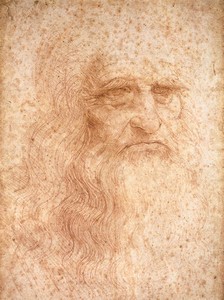 philosophies display extreme creativity and brilliance, and have had a dramatic impact upon many generations, including ours today.
philosophies display extreme creativity and brilliance, and have had a dramatic impact upon many generations, including ours today.
Leonardo Da Vinci was the illegitimate son of a notary, Ser Piero, and a peasant girl, Caterina. He was born on 15 th April 1452, in a town neighboring Florence; and eventually became a brother to 17 younger, half siblings. Raised by his father, he was exposed to a vast library of academic literature and his father's love for painting. At the age of fifteen, Da Vinci became an apprentice to Andrea del Verrochio; where he worked for 7 years and displayed such artistic skill that Verrochioi supposedly resolved to never paint again.
Da Vinci used science to further improve his art. It was due to his study on the nature of light and shadow that he realised objects were not composed of outlines, rather, of three-dimensional objects which were defined by light and shadow.
Between 1482-1499, Leonardo Da Vinci was commissioned by the Duke of Milan to construct weapons, engineer machinery and design buildings; as well as to continue practising his fine skills in painting, sculpting and over-seeing the kings decorative festivals.
Leonardo Da Vinci desired to invent machines for a “future world”. In his attempt to measure time he constructed mechanical gears, which he later used in his design for a bicycle, an “auto-mobile” and a helicopter. Due to the nonexistence of electricity at this time, Da Vinci meticulously studied all forms water, devising plans on how to best untilise water to measure humidity and power waterwheels and cannons.
Due to the French invasion of Italy and the fall of Ludovico Sforza in 1499, Da Vinci spent the next 16 years doing free-lance work. During this period he worked as a military engineer; he anticipated the idea of constructing a bridge to Constantinople; he was commissioned to paint the “Battle of Anghiari”, and, in 1503, he supposedly commenced painting the world renowned “Mona Lisa”.
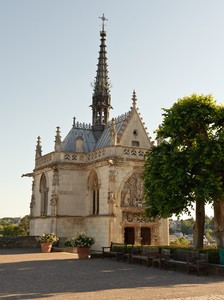 It was in 1516, at the peak of the Renaissance, that Leonardo Da Vinci entered into the service of Francois I, the king of France; arriving with just three paintings (one of which was the ‘Mona Lisa') and a few items tied to his mule. He took up residence in the Chateau de Clos Lucé, near to the royal Chateau d'Amboise. He spent the last three years of his life as the first architect, painter and engineer to the king. Unhindered by the paralysis of his right hand, Da Vinci continued writing and drawing. He further developed his anatomical studies, as well as his studies on hydraulics; at one stage proposing to reroute rivers in order to connect the royal Loire castles. On the 2nd May 1519, Leonardo Da Vinci died with Francois I by his side. François I is reported as saying: “ No man ever lived who had learned as much about sculpture, painting, and architecture, but still more that he was a very great philosopher” . Leonardo Da Vinci is buried at the Chateau d'Amboise, in the Chapel of Saint-Hubert.
It was in 1516, at the peak of the Renaissance, that Leonardo Da Vinci entered into the service of Francois I, the king of France; arriving with just three paintings (one of which was the ‘Mona Lisa') and a few items tied to his mule. He took up residence in the Chateau de Clos Lucé, near to the royal Chateau d'Amboise. He spent the last three years of his life as the first architect, painter and engineer to the king. Unhindered by the paralysis of his right hand, Da Vinci continued writing and drawing. He further developed his anatomical studies, as well as his studies on hydraulics; at one stage proposing to reroute rivers in order to connect the royal Loire castles. On the 2nd May 1519, Leonardo Da Vinci died with Francois I by his side. François I is reported as saying: “ No man ever lived who had learned as much about sculpture, painting, and architecture, but still more that he was a very great philosopher” . Leonardo Da Vinci is buried at the Chateau d'Amboise, in the Chapel of Saint-Hubert.
RiverLoire is passionnate about the man genius and organizes private guided tours of the Chateau of Amboise and Chateau of Clos Lucé. Contact us to book a tour.
The Plantagenets
The Plantagenet Dynasty, otherwise known as the Angevins, originates from a noble French family who ruled in Anjou, northern France, during the 12 th century. Between 1154-1399 the Plantagenets came to power in England, a period during which they produced 14 heirs.
The advantageous marriage between Geoffrey of Anjou and King William of England's granddaughter, Matilda, in 1128 resulted in a son, Henri who, in 1216, was crowned King of England. Henri II's successors include King Edward I, King Edward II, King Edward III until the murder of King Richard II in 1399. The Plantagenet crown was then divided between the conflicting House of York and the House of Lancaster.
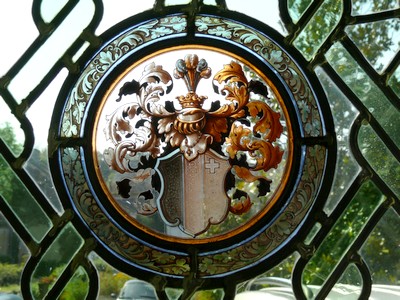 The name, Plantagenet, is said to have derived from Geoffrey of Anjou's custom of wearing the golden flower on his hat, thus the surname was later applied to his descendants who had no last name. The Plantagenets were generally regarded as a disorderly and wild bunch.
The name, Plantagenet, is said to have derived from Geoffrey of Anjou's custom of wearing the golden flower on his hat, thus the surname was later applied to his descendants who had no last name. The Plantagenets were generally regarded as a disorderly and wild bunch.
The Plantagenet Dynasty ruled England during a period when major historical developments were occurring. King Edward I had conquered Wales in his attempt to create a British empire, but failed in his attempt to seize Scotland. Edward II reigned during the Hundred Years War, a feud between England and France, and Richard II witnessed the beginning of the War of the Roses, a time of social struggle.
It was also during the reign of the Plantagenet Dynasty that new social institutions were evolving and the judicial reforms (between the reign of Henri II and Edward I) saw the expansion of English Parliament. The ‘Black Death' caused excessive social unrest and employment shortages and the rise in prices contributed to the Peasant's Revolt in 1381. However, regardless of these struggles, the cultures of art and learning flourished and a distinct English culture began to emerge.
Part of our Loire Valley Tours, RiverLoire organizes tours focused on History such as our Fully Guided Loire Valley Tour.
City of Tours
The cosmopolitan city of Tours is the largest city residing in the Loire Valley. Located between both the Loire River and one of its many tributaries, the Cher River, Tours is the perfect base for exploring Touraine's stunning Loire castles and discovering fantastic Loire Valley wines. The city of Tours itself has much to offer visitors. It is home to over 140,000 people who are renowned for speaking the “purest” form of French in the whole of France. Tours also has an intensely rich history; associated with the Battle of Tours in 732 ACE and the famous evangelist of the 4th century, Saint Martin.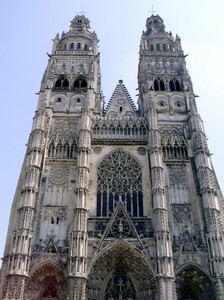
The popular sun-drenched square, Place Plumereau, provides many lively Loire Valley restaurants, bars and cafes and is located within the 15th century medieval town, Le Vieux Tours. Visitors can stroll through its quaint, narrow streets, and discover its old half-timbered houses and many chic boutiques and cafés.
The grand 19th century New Basilica is where the tomb of Saint Martin now lies. The basilica was built on the grounds of the medieval Old Basilica, which was home to Saint Martin. Today, the remaining two towers – the Tour Charlemagne and the Tour de l'Horloge – located on either side of the rue des Halles, are remnants of the previous building, providing visitors with fantastic insight into the Christian heritage of this area.
Visitors can witness the spectacular Saint Gatien Cathedral, the cathedral of Tours, which was constructed from the 12th century until the mid 16th century. This extensive building period is reflected in its magnificent facade. Whilst the Gothic-style influence of the 15 th century and its Renaissance pinnacles are most dominant, remnants of the building belong to the 12th century.
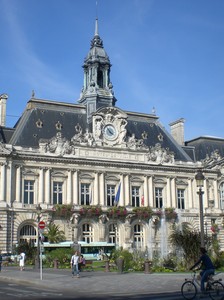 Many museums boast the rich history of Tours and the surrounding Loire Valley. The Musée des Beaux-Arts, the Museum of Fine Art, exhibits a wonderful collection of paintings from the Middle Ages to contemporary artists, and is situated next to the Cathédrale St-Gatien. For visitors with an interest in wine making, the Musée Vins des Touraine, located in the cellars of the Eglise St-Julien, exhibits a large Renaissance winepress, wine making tools from the Middle Ages and the viticultural history of the Loire Valley.
Many museums boast the rich history of Tours and the surrounding Loire Valley. The Musée des Beaux-Arts, the Museum of Fine Art, exhibits a wonderful collection of paintings from the Middle Ages to contemporary artists, and is situated next to the Cathédrale St-Gatien. For visitors with an interest in wine making, the Musée Vins des Touraine, located in the cellars of the Eglise St-Julien, exhibits a large Renaissance winepress, wine making tools from the Middle Ages and the viticultural history of the Loire Valley.
For visitors with a keen interest in shopping, the central shopping streets of Tours, Avenue de Grammont and rue Nationale, are lined with the highest quality designer shops and is sure to please any shopper. The mid year sales prove to be the best time for shoppers, with discounts of up to 60%.
There is easy transport access to and from Tours. Ryanair, flies daily from London Stansted Airport to Tours Loire Valley Airport, and vice versa. Alternatively, Tours is a central station connecting with the TGV. From here run regular lines to Bordeaux, Avignon and Paris (Paris is just one hour by TGV train...
All of our Loire Valley Tours can include a day in the city of Tours, at your own pace or with a professional guide. Whatever your choice, RiverLoire will provide you with pedestrian detailed itineraries of the city of Tours to allow you to visit this lively and amazing town.
City of Amboise
Amboise, "Ambacia" in Latin, means " between two waters ". The name of the city makes reference to its past and to its privileged geographical situation: the plateau of the «Châteliers» which overhangs the Loire Valley and the Amasse River. The city grew, taking advantage of the natural protection of the waters and of the edification of a fortified town.
Amboise is an ancient gem in the Loire Valley and is the perfect holiday location for all ages and interests. Situated along the picturesque Loire River, its quaint streets and magnificent Chateau d'Amboise boast historical richness, fine dining and a wonderful shopping experience.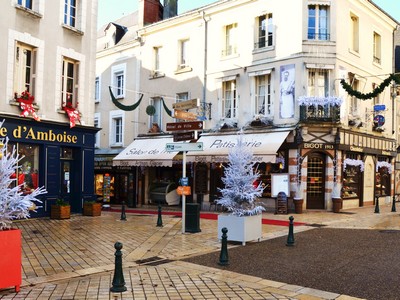
Its rich history dates back to 1434 as the royal residence of King Charles VII; but is most widely recognised as the final resting place of Leonardo Da Vinci. During the 1500's, upon the invitation of King Francois I, Leonardo Da Vinci resided in the region and contributed to the king's extravagant festivals. A legacy which is evident today by the presence of the magnificent Renaissance castle and Leonardo Da Vinci's Chateau du Clos Lucé – which exhibits 40 of his ingenious writings, plans and invention reproductions.
Located within Amboise is the Parc des Mini Chateaux, a fantastic 2-hectare family park displaying 44 miniature castles of the Loire Valley built to a 1:25 scale. Amongst the hills above Amboise stands the Pagoda Chanteloup ; a symbol of royal authority built in 1775, under the instruction of the Duke of Choiseul. This Chinese style structure was constructed out of appreciation to the Duke's friends who had accompanied him during his exile in 1770.
Most of our Loire Valley Tours include a private guided visit of Amboise. You may also have the opportunity to sleep in this charming royal town... Please do not hesitate to contact us.








